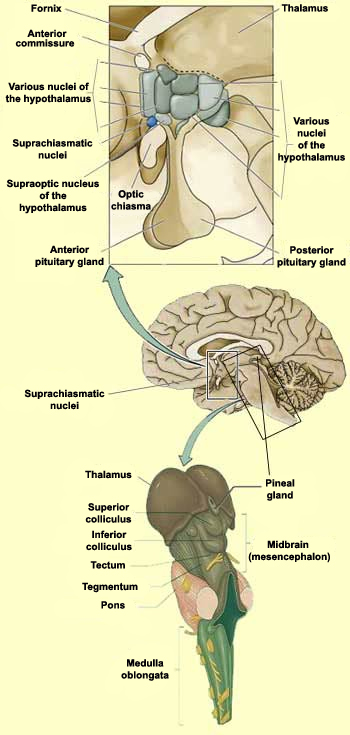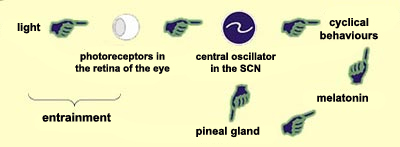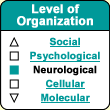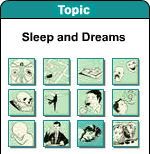|
|



A number of studies
have shown that the central oscillator in the SCNs is not
the only biological clock in the human body, and that the genes
of the human biological clock are also expressed
cyclically in many peripheral tissues, such as the liver,
heart, skin, and lymphocytes.
These peripheral clocks are co-ordinated
by the central clock in the SCNs, which is synchronized with
the day/night cycle by the direct influence of the ambient
light. This central clock then communicates with the peripheral
ones via the nervous and circulatory systems, so that these
peripheral clocks can in turn synchronize themselves with the
central oscillator. These peripheral clocks may also be influenced
by other
entraining factors, such as the timing of meals.
|
In addition
to affecting the production of melatonin indirectly, via
the pineal gland, the suprachiasmatic nuclei may also release
certain peptides directly into the cerebrospinal fluid, such
as arginine vasopressin (AVP)
during the daytime and vasoactive intestinal peptide (VIP)
at night.
|
|
|
| THE SUPRACHIASMATIC NUCLEI AND THE PINEAL
GLAND |
|
There is a part of the brain that can
maintain a basic, independent rhythm even if the external
cues of the cycle of day and night are eliminated.
Scientists have determined that in
mammals, this “biological
clock” is located in two tiny structures called the suprachiasmatic
nuclei (SCNs), located in the left and the right hypothalamus and
bordering on the third ventricle. The neurons of these two nuclei
are among the smallest in the brain.
To maintain its accuracy, this central biological clock resynchronizes
itself each day with
external stimuli such as the brightness of the ambient light,
by means of the optic
nerves, which bring this information to it from special
ganglion cells in the retina.
The output pathways from each SCN consist of axons that innervate
mainly the hypothalamus and nearby structures. Some of these axons
also project to other parts of the diencephalon (forebrain),
while others project to the mesencephalon (midbrain).
 |
Lastly, both SCNs also send signals,
though indirectly, to another very important structure:
the pineal
gland. In birds, reptiles, and fish, this small
gland located
at the top of the brain is sensitive to light and co-ordinates
some cyclical phenomena on its own. In mammals, however,
though the pineal gland does retain its ability to produce
secretions cyclically (specifically, the hormone melatonin,
at night), it does not constitute a clock on its own; instead,
its cyclical synthesis of melatonin is controlled by timing
signals that it receives from the SCNs.
Each day, the pineal gland begins to
produce melatonin (sometimes
called the “sleep hormone”) as
night falls. As the level of melatonin in the blood rises,
body temperature falls slightly, and the
individual feels sleepier and sleepier. The melatonin
level remains high for just about 12 hours, then starts falling
again in the early morning, as daylight inhibits this gland’s
activity. |
Scientists do not yet know the details of how the central biological
clock in the SCNs regulates so many different human cyclical behaviours.
| But scientists
do know that it uses the pineal gland to do so, and they have
shown that destroying the SCNs’ output pathways also
destroys the body’s circadian rhythms. |
 |
Because GABA is
the essential neurotransmitter for almost all of the SCNs’ neurons,
one would expect an inhibitory effect on the neurons that they
innervate. In addition to sending out messages along these axonal
pathways, the SCNs’ neurons seem to secrete a neuropeptide
called vasopressin in
a cyclical pattern. It has been shown that this pattern arises
because the segment of the gene for vasopressin that causes it
to be produced (its “ON” switch, so to speak) is controlled
by the same proteins as the genetic
feedback loops that are the molecular basis for the human biological
clock. Lastly, it should be noted that the effects of the vasopressin
that is secreted by the neurons of the SCNs are limited to the
brain, contrary to those of pituitary vasopressin, which is involved
in the water metabolism of the entire body.
|
|






